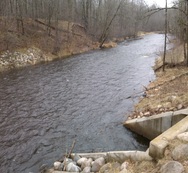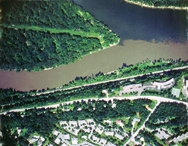|
The Request for
Proposal (RFP) process for Surface Water Assessment Grants (SWAG) is now open. Agreements under this program are funded by the Minnesota
Clean Water Fund (Legacy Amendment). The Minnesota Pollution Control Agency (MPCA)
will award up to $550,000 through a competitive process. All proposals must be submitted
through the SWIFT e-supplier portal and must be received no later than Jan. 6. Proposals
received after this deadline will not be considered.
Eligible proposers
must have a SWIFT Vendor ID and Supplier Portal Account to access the RFP and
apply for the SWAG. Additionally, local partners who are awarded and agreement
will be required to use SWIFT to review and approve, through electronic
signature, the final agreement and work plan.
Detailed registration directions are available on the SWIFT
e-supplier portal. Proposers should be aware that it can take
several days to receive a required Vendor ID from SWIFT. If you need technical
assistance for the SWIFT e-supplier portal, please contact the SWIFT helpdesk
line: 651-201-8100, option 1.
The primary objective of the SWAG is to
determine the health of Minnesota lakes and streams. Through this program,
local partners collect information that identifies waters which are in need of
restoration or protection strategies. The MPCA works with local partners to
focus these strategies at the major watershed scale.

Monitoring locations for this RFP are located
within the following watersheds:
Additional information
for this program can be found at the MPCA’s SWAG webpage.
|

The
Minnesota Dept. of Natural Resources is now accepting grant applications for
metro projects that qualify for the Conservation Partners Legacy program. $1.6
million is available for conservation projects in the 7-county metro area or
cities with a population of 50,000 people or greater. This includes the
counties of Anoka, Carver, Dakota, Hennepin, Ramsey, Scott, and Washington, and
the cities of Duluth, Rochester, and St. Cloud. Projects must be on public
lands/waters or on lands permanently protected by a conservation easement.
The
CPL program funds projects that restore, enhance,
or protect forests, wetlands, prairies, or habitat for fish, game and wildlife
in Minnesota. Grant requests may range from $5,000 to $400,000 with a maximum
total project cost of $575,000. Nonprofit organizations and government entities
are eligible to apply, and a 10% match of non-state funds is required. Applications are available online and are due Jan.
29 at 4 p.m.
For
more information, check out the Request for Proposal or visit the DNR website. Questions? Please email lscplgrants.dnr@state.mn.us.
|

It’s
more good news than bad for the Pine River watershed in central Minnesota,
according to intensive water monitoring and stressor identification by the MPCA
and local partners. Issues like low dissolved oxygen, excess sediment, and
elevated nutrients seem to be isolated to a handful of tributaries.
From
its source at Pine Mountain Lake in Cass County (about a half mile west of
Backus), the Pine River flows southeast to its confluence with the Mississippi
River, 10 miles north of Brainerd. The Pine River watershed begins in Cass
County and flows into Crow Wing County, covering 779 square miles and draining about
498,560 acres.
The
watershed includes the Whitefish Chain of Lakes that runs through the center
from west to east. The northern half of the watershed is predominately forest
and wetland with scattered agricultural lands. The southwestern portion of the
watershed is opposite, with predominately forests, agricultural lands,
scattered wetlands, and small lakes.
Water
bodies showing signs of stress to fish and other aquatic life include:
- Arvig
Creek with low dissolved oxygen levels
- South
Fork Pine River with excess sediment and suspended solids
- Wilson
Creek that shows the most notable levels of increased nitrogen and phosphorus
Continued
health of this watershed is aided by passionate work by grassroots groups like
the Pine River Watershed Alliance and lake associations throughout the
Whitefish Chain of Lakes.
The
Pine River watershed biotic stressor identification report and a two-page
summary are available on its MPCA watershed webpage.
|

High
bacteria levels and increased sediment are the main stressors to fish and other
aquatic life in the Redeye River watershed, according to intensive water
monitoring and stressor identification by the MPCA and local partners.
The
Redeye River watershed covers nearly 900 square miles in the northern part of
the Upper Mississippi River Basin in central Minnesota. The watershed includes
all or parts of Becker, Otter Tail, Todd, and Wadena counties.
The
Redeye River begins at Wolf Lake and joins the Leaf River, before draining into
the Crow Wing River near Staples. The river provides drinking water for
households and industries, habitat for aquatic life, riparian corridors for
wildlife and recreational opportunities like fishing, swimming, and canoeing.
Nearly half the watershed’s land use is agricultural, 30% is forested, 15% is
wetlands, and about 4% is developed communities and industries.
Of
the waters that fail to fully support aquatic life or recreation, the main
source of impairments are due to high bacteria levels and increased sediment.
Primary resource concerns are soil erosion by wind and water, surface and
ground water management, and changing land use patterns. Increased development,
wetland removal, and agriculture have all likely contributed to increased
sediment and bacteria to lakes and streams, leading to reduced populations of
sensitive aquatic species.
Water
bodies with identified impairments and subsequent biologic stressors include
South Bluff Creek, Wing River, Union Creek, and tributaries to East Leaf Lake
and the Leaf River.
Local
partners like the Wadena County SWCD and Otter Tail County coalition of lake
associations have helped the stressor identification work by MPCA staff.
The
Redeye River watershed stressor identification report and a two-page summary
are available on the MPCA’s Redeye River watershed webpage.
|

The 2015 Watershed Achievement Report
highlights the multiple projects and efforts to protect and restore waters
throughout Minnesota. Highlights in the 2015 report include:
- Minnesota’s statewide buffer initiative to
filter runoff flowing to lakes and rivers.
- Intensive
water monitoring started or completed in 69 of the state’s 80 major watershed,
providing extensive data for identifying stressors to aquatic life and
developing strategies to restore and protect waters.
- Watershed Restoration
and Protection Strategies are underway for nearly all major watersheds.
- Projects
throughout Minnesota center on better filtering of stormwater, facilitating
behavior change that benefits water quality, designing ditches to slow and
filter runoff, assisting feedlots with reducing pollutants, installing sewer
systems, and much more.
The MPCA
submits this report on Clean Water Act
Section 319, Clean Water Partnership, and Clean Water fund projects
in Minnesota to the U.S. Environmental Protection Agency every year.
|
Gov. Mark Dayton,
at the annual meetings of the Minnesota Farm Bureau and the Minnesota
Farmers Union, announced his plans to convene a statewide Water Quality
Summit in February. The summit will focus public attention on the
serious challenges facing Minnesota’s water supplies – in both rural and
urban areas of the state – and continue statewide dialogue around steps
that must be taken to address those challenges.
The
summit will include water quality experts, farmers, legislators,
regulators, the business community, members of the public, local
leaders, and a wide variety of other stakeholders. “My
father believed – as I believe – that stewardship is a profound
responsibility of each of us. To take what we have been given – or have
acquired – and leave it in better condition for those who will inherit
from us,” Gov. Dayton said. “This is everyone’s challenge, and
everyone’s responsibility.”
In
his remarks to the Minnesota Farm Bureau, Gov. Dayton
elaborated on the need for a statewide Water Quality Summit, and provided some
additional information about what the summit may address. Audio of the governor's remarks can be found here. Additional details about the Governor's Water
Quality Summit will be provided in the coming weeks. Star Tribune editorial, Nov. 25, 2015: "Water quality is a worthy signature issue for Dayton."
The new,
citizen-led organization to promote the natural resource and economic health of
the Minnesota River basin is closing in on filling all 33 seats on its
governing Action Board.
Nineteen members
were named at the fifth Minnesota River Congress Nov. 12 in New Ulm. The Action
Board applications were approved by 93 people attending. Applications since
then have raised the total to 24, says Scott Sparlin of Coalition for a Clean
Minnesota River.
When
complete, the Action Board will include representatives from each of the
basin’s 13 major watersheds, and various sectors such as agriculture, business, recreation,
and local and state agencies. It will set policy, goals, and objectives for the
Congress. It will name a management committee to handle operations such as
finance and communications.
In other
business Nov. 12, the Congress voted to support proposed legislation (Senate File 2204)
creating a
Minnesota River Commission. The support is conditional upon an
opportunity for
the Congress to provide input on the final draft. Photo: Linda Loomis of
the Lower Minnesota River Watershed District spoke about the
legislation.
The next Congress
will be scheduled in late February or early March.

After almost four years of processing
400-plus comments and several requests for contested case hearings, the MPCA
has finished revisions to the South Metro Mississippi Total Maximum Daily
(TMDL) report and submitted it to the U.S. Environmental Protection Agency for
final approval. The report addresses the total suspended solids impairment in
the river from St. Paul to Lake Pepin. (Photo: Plume of sediment entering
the Mississippi from the Minnesota River.)
During the 2012 public
comment period, the agency received requests for contested case hearings from
the following entities:
- City of Minneapolis;
- Minnesota Cities Stormwater Coalition / League of Minnesota
Cities and several other member cities or entities;
- Minnesota Soybean Growers Assoc., Brown County Corn and Soybean
Growers, and several individual producers; and
- Lake Pepin Legacy Alliance.
After discussions and
other communication with MPCA staff, the city of Minneapolis, the Minnesota
Cities Stormwater Coalition / League of Minnesota Cities (and most of the
member cities / entities) and the Lake Pepin Legacy Alliance withdrew their
hearing requests. After much review and discussion, the MPCA denied the
other hearing requests.
The revised TMDL report
is available on the South Metro Mississippi
webpage. Revisions include updates to research, TMDL reports for contributing
watersheds, list of regulated wastewater and stormwater entities, and
implementation strategies.
Notable
changes include removing the across-the-board 25% reduction for all municipal separate
storm sewer systems (MS4s) regardless
of location and removing the baseline year. The need for a reduction is now
based on an MS4’s location within the drainage area and other factors. For details, see the Response to Comments document on
the project webpage.
The majority of sediment
in this stretch of the Mississippi originates in the Greater Blue Earth River
and Minnesota River.
The agency is working on revisions to TMDL reports for those river systems. The
revisions address changes in water quality
standards.
|
The
City of Eagan is partnering with Metropolitan Council Environmental Services and
Barr Engineering to study the feasibility of using reclaimed water from the
Seneca Wastewater Treatment Plant. The idea is to shift non-potable demands
(like irrigation, firefighting, and vehicle washing) from the city’s treated,
potable water supply to reclaimed wastewater.
In
addition to reducing demand on the groundwater aquifer the city uses for its potable
water supply, this could reduce treatment and water supply costs for users,
improve regional source water sustainability, and may even provide a recharge
source for groundwater.
This
project will be the focus of the Mississippi River Forum Friday, Dec. 18, from
8-9:30 a.m. at the McKnight Foundation in Minneapolis and Friday, Jan. 8, from
8-9:30 a.m. at the City Council Chambers in St. Cloud.
There is no charge to attend the forum or for
the light breakfast served but an RSVP to Lark Weller of the National Park
Service is requested.
The Jan. 8 forum is also available by webinar
and conference call. See connection details on the National Park Service website.
Dayton
pushes for $800 million water-quality farmland easement plan in the Pioneer
Press
In Minnesota's farm country, clean water is
costly in the StarTribune
Experiment looks at effect of
pharmaceuticals on fish on Minnesota Public Radio
State agencies nix PolyMet public health
impact review in the Pioneer Press
For the sake of our lakes, keep your
pavement on a low-salt diet in an MPCA news release
|